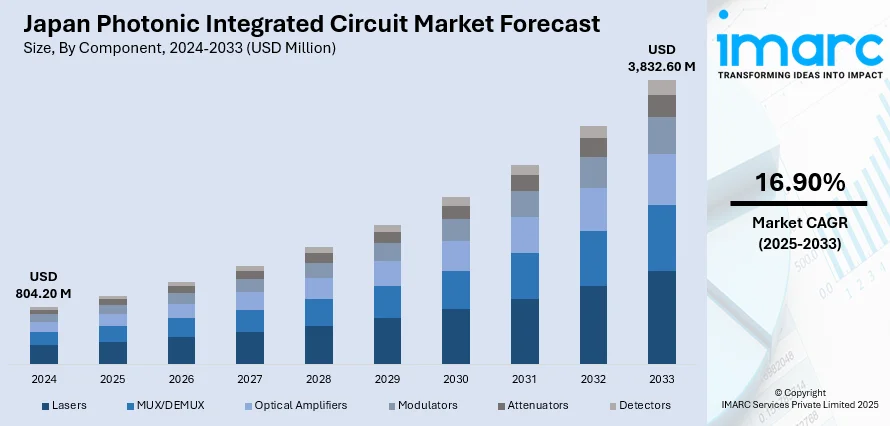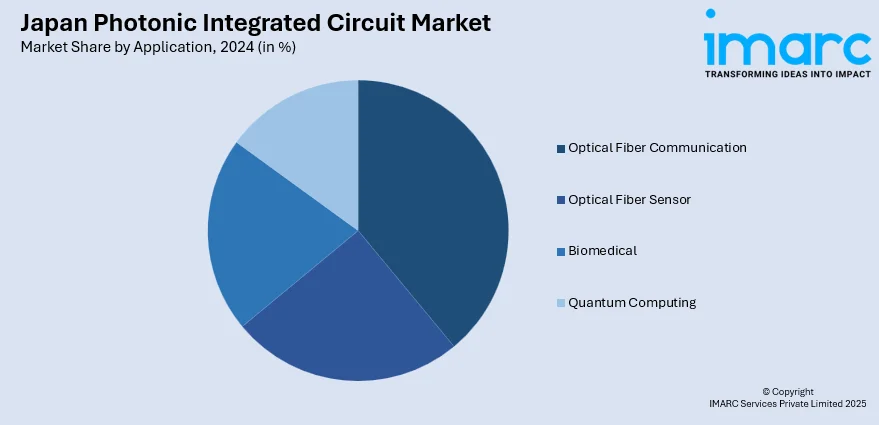
Japan Photonic Integrated Circuit Market Size, Share, Trends and Forecast by Component, Raw Material, Integration, Application, and Region, 2025-2033
Japan Photonic Integrated Circuit Market Overview:
The Japan photonic integrated circuit market size reached USD 804.20 Million in 2024. Looking forward, IMARC Group expects the market to reach USD 3,832.60 Million by 2033, exhibiting a growth rate (CAGR) of 16.90% during 2025-2033. The market is experiencing robust growth, spurred by the elevating demand for high-speed data transmission, particularly with the expansion of 5G and the anticipated shift to 6G networks, Japan's strong semiconductor manufacturing ecosystem, and the integration of photonics in emerging technologies, such as quantum computing and artificial intelligence.
|
Report Attribute
|
Key Statistics
|
|---|---|
|
Base Year
|
2024 |
|
Forecast Years
|
2025-2033
|
|
Historical Years
|
2019-2024
|
| Market Size in 2024 | USD 804.20 Million |
| Market Forecast in 2033 | USD 3,832.60 Million |
| Market Growth Rate 2025-2033 | 16.90% |
Japan Photonic Integrated Circuit Market Trends:
Expansion of High-Speed Data Infrastructure
Japan’s robust digital transformation efforts have fueled significant investments in telecommunications and data center infrastructures, creating strong momentum for the adoption of photonic integrated circuits (PICs), which are crucial for high-speed, low-latency data transmission. The country’s telecom market reached USD 137,207 million in 2024 and is projected to grow to USD 202,768 million by 2033, at a CAGR of 4.4% between 2025 and 2033. This steady growth reflects Japan’s expanding digital ecosystem. In parallel, the nation has rapidly advanced 5G deployment, with over 90 million 5G subscriptions recorded by March 2024. Prefectures like Kanagawa and Osaka lead the country in coverage, achieving a remarkable 99.9% 5G penetration. This rollout demands advanced optical infrastructure, where PICs provide the necessary scalability and performance. Additionally, Japan’s growing data consumption has led to the expansion of modern data centers, where PICs enhance bandwidth efficiency and reduce latency. These developments solidify Japan’s position as a regional frontrunner in photonics, bolstering the market growth.

Integration of PICs in Healthcare and Smart City Applications
Beyond telecommunications, PICs are playing a pivotal role in advancing Japan’s healthcare and smart city initiatives, in alignment with the nation's broader technological ambitions. In healthcare, PICs enable precise, real-time data analysis, significantly improving medical diagnostics and patient outcomes. Researchers are also developing silicon photonics-based biosensors capable of detecting multiple biomarkers simultaneously, facilitating early disease diagnosis. Meanwhile, Japan's smart cities market is experiencing robust growth, having reached USD 84.1 billion in 2024. The market is expected to surge to USD 286.6 billion by 2033, growing at a CAGR of 14.6% from 2025 to 2033. PICs are essential for this transformation, underpinning critical smart infrastructure with advanced communication capabilities and efficient data handling. With the proliferation of IoT devices across urban environments, the need for high-speed, reliable connectivity is rising, and PICs meet this demand by ensuring seamless data transmission.
Japan Photonic Integrated Circuit Market Segmentation:
IMARC Group provides an analysis of the key trends in each segment of the market, along with forecasts at the region/country level for 2025-2033. Our report has categorized the market based on component, raw material, integration, and application.
Component Insights:
- Lasers
- MUX/DEMUX
- Optical Amplifiers
- Modulators
- Attenuators
- Detectors
The report has provided a detailed breakup and analysis of the market based on the component. This includes lasers, MUX/DEMUX, optical amplifiers, modulators, attenuators, and detectors.
Raw Material Insights:
- Indium Phosphide (InP)
- Gallium Arsenide (GaAs)
- Lithium Niobate (LiNbO3)
- Silicon
- Silica-on-Silicon
A detailed breakup and analysis of the market based on the raw material have also been provided in the report. This includes indium phosphide (InP), gallium arsenide (GaAs), lithium niobate (LiNbO3), silicon, and silica-on-silicon.
Integration Insights:
- Monolithic Integration
- Hybrid Integration
- Module Integration
The report has provided a detailed breakup and analysis of the market based on the integration. This includes monolithic integration, hybrid integration, and module integration.
Application Insights:

- Optical Fiber Communication
- Optical Fiber Sensor
- Biomedical
- Quantum Computing
A detailed breakup and analysis of the market based on the application have also been provided in the report. This includes optical fiber communication, optical fiber sensor, biomedical, and quantum computing.
Regional Insights:
- Kanto Region
- Kansai/Kinki Region
- Central/Chubu Region
- Kyushu-Okinawa Region
- Tohoku Region
- Chugoku Region
- Hokkaido Region
- Shikoku Region
The report has also provided a comprehensive analysis of all the major regional markets, which include Kanto Region, Kansai/Kinki Region, Central/Chubu Region, Kyushu-Okinawa Region, Tohoku Region, Chugoku Region, Hokkaido Region, and Shikoku Region.
Competitive Landscape:
The market research report has also provided a comprehensive analysis of the competitive landscape. Competitive analysis such as market structure, key player positioning, top winning strategies, competitive dashboard, and company evaluation quadrant has been covered in the report. Also, detailed profiles of all major companies have been provided.
Japan Photonic Integrated Circuit Market News:
- August 2024: Renesas completed its acquisition of Altium for approximately JPY 887.9 billion. This move integrated Altium’s PCB software with Renesas's semiconductor expertise, enabling streamlined design platforms and enhanced productivity. The acquisition supports technologies like the PICs by simplifying complex development processes and making electronics design more accessible.
- January 2024: Intel, SK Hynix, and NTT Japan partnered to develop next-generation PICs technology aimed at slashing semiconductor power consumption by 30–40%. Backed by JPY 45 billion from Japan’s government, the collaboration focused on silicon photonics to support AI and data center growth.
Japan Photonic Integrated Circuit Market Report Coverage:
| Report Features | Details |
|---|---|
| Base Year of the Analysis | 2024 |
| Historical Period | 2019-2024 |
| Forecast Period | 2025-2033 |
| Units | Million USD |
| Scope of the Report | Exploration of Historical Trends and Market Outlook, Industry Catalysts and Challenges, Segment-Wise Historical and Future Market Assessment:
|
| Components Covered | Lasers, MUX/DEMUX, Optical Amplifiers, Modulators, Attenuators, Detectors |
| Raw Materials Covered | Indium Phosphide (InP), Gallium Arsenide (GaAs), Lithium Niobate (LiNbO3), Silicon, Silica-on-Silicon |
| Integrations Covered | Monolithic Integration, Hybrid Integration, Module Integration |
| Applications Covered | Optical Fiber Communication, Optical Fiber Sensor, Biomedical, Quantum Computing |
| Regions Covered | Kanto Region, Kansai/Kinki Region, Central/Chubu Region, Kyushu-Okinawa Region, Tohoku Region, Chugoku Region, Hokkaido Region, Shikoku Region |
| Customization Scope | 10% Free Customization |
| Post-Sale Analyst Support | 10-12 Weeks |
| Delivery Format | PDF and Excel through Email (We can also provide the editable version of the report in PPT/Word format on special request) |
Key Questions Answered in This Report:
- How has the Japan photonic integrated circuit market performed so far and how will it perform in the coming years?
- What is the breakup of the Japan photonic integrated circuit market on the basis of component?
- What is the breakup of the Japan photonic integrated circuit market on the basis of raw material?
- What is the breakup of the Japan photonic integrated circuit market on the basis of integration?
- What is the breakup of the Japan photonic integrated circuit market on the basis of application?
- What are the various stages in the value chain of the Japan photonic integrated circuit market?
- What are the key driving factors and challenges in the Japan photonic integrated circuit market?
- What is the structure of the Japan photonic integrated circuit market and who are the key players?
- What is the degree of competition in the Japan photonic integrated circuit market?
Key Benefits for Stakeholders:
- IMARC’s industry report offers a comprehensive quantitative analysis of various market segments, historical and current market trends, market forecasts, and dynamics of the Japan photonic integrated circuit market from 2019-2033.
- The research report provides the latest information on the market drivers, challenges, and opportunities in the Japan photonic integrated circuit market.
- Porter's five forces analysis assist stakeholders in assessing the impact of new entrants, competitive rivalry, supplier power, buyer power, and the threat of substitution. It helps stakeholders to analyze the level of competition within the Japan photonic integrated circuit industry and its attractiveness.
- Competitive landscape allows stakeholders to understand their competitive environment and provides an insight into the current positions of key players in the market.
Need more help?
- Speak to our experienced analysts for insights on the current market scenarios.
- Include additional segments and countries to customize the report as per your requirement.
- Gain an unparalleled competitive advantage in your domain by understanding how to utilize the report and positively impacting your operations and revenue.
- For further assistance, please connect with our analysts.
 Request Customization
Request Customization
 Speak to an Analyst
Speak to an Analyst
 Request Brochure
Request Brochure
 Inquire Before Buying
Inquire Before Buying




.webp)




.webp)












